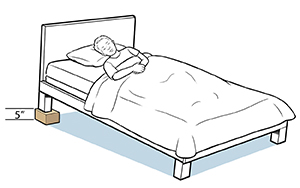GERD stands for gastroesophageal reflux disease. You may also hear it called acid indigestion or heartburn. It happens when stomach contents flow back up (reflux) into the tube that connects the mouth to the stomach. This tube is called the esophagus. Most children and adults have gastroesophageal reflux once in a while, but it becomes a disease (GERD) when it causes repeated symptoms that are troublesome or lead to complications. GERD can irritate the esophagus. It can cause problems with swallowing or breathing. In severe cases, GERD can cause serious problems, such as pneumonia that keeps coming back. So it’s best for any child with GERD to be seen by a health care provider.
Symptoms of GERD in children
GERD can cause symptoms such as:
-
A burning feeling in the chest, neck, or throat (heartburn).
-
A feeling of food or liquid coming up in the back of the mouth (regurgitation)
-
Gagging, choking, or trouble swallowing.
-
Frequent wheezing episodes.
-
A cough that doesn’t go away (persistent cough), especially at night or when you wake up.
-
A hoarse or raspy voice.
-
Bad breath.
-
A sore throat in the morning.
Infants with GERD may be fussy, arch their back, or refuse to feed. But infants who don't have GERD often have these same symptoms.
Diagnosing GERD
Your child's health care provider may diagnose GERD based on your child's symptoms. In some cases, testing may be done to find what is causing your child’s symptoms. Common tests for diagnosing GERD include:
-
Upper GI series, also called a barium swallow. Barium is a thick, chalky liquid. When swallowed, it makes the esophagus and stomach show up on X-rays.
-
Endoscopy. Your child is given a medicine (anesthesia) to make them fall asleep. Then a tube (endoscope) with a light and a tiny video camera on it is put down your child’s throat. This lets the provider look at your child’s esophagus and stomach. During this test, your provider may attach a temporary capsule (a pH capsule) to your child's esophagus to measure acid reflux. Information is sent to a recording device that the provider analyzes. This capsule will come off after a few days and be passed in your child's stool. You may or may not see it pass.
-
A 24-hour esophageal pH study. The provider puts a very thin tube into your child’s esophagus. This tube is connected to a monitor that records acid levels and reflux activity for a day or longer. When combined with a feature called impedance monitoring, it checks for acid reflux plus regurgitation of other fluid.
Treating GERD in children
Treatment depends on your child’s age and how severe the symptoms are. Sometimes symptoms can cause poor weight gain. In many cases, making the changes listed below will be enough to ease symptoms. In some cases, medicines may be prescribed to help reduce stomach acid. Rarely, surgery may be advised for severe symptoms that don’t respond to treatment.
Helping your child feel better
To help prevent or reduce GERD symptoms:
-
Have your child eat smaller but more frequent meals.
-
Make sure your child stops eating at least 3 hours before going to bed.
-
Don't let your child lie down or recline for 2 hours after meals.
-
Stay away from food and drink that can make GERD worse. These include:
-
Chocolate, peppermint, fizzy drinks, and drinks that have caffeine.
-
Acidic foods (such as vinegar, citrus fruits and juices, and tomato products).
-
High-fat foods (such as french fries, fast food, and pizza).
-
Spicy foods.
-
Fried foods.
-
-
Raise the head of your child’s bed 5 inches. This can help prevent reflux at night.
-
Make sure your child’s clothing is loose and comfortable, especially around the waist.
-
Talk to your child's provider about ways to help your child stay at an ideal weight.
-
Keep tobacco smoke away from your child.
Featured in


